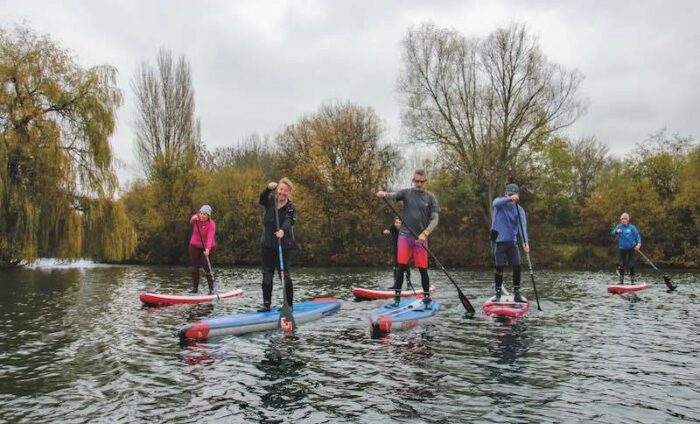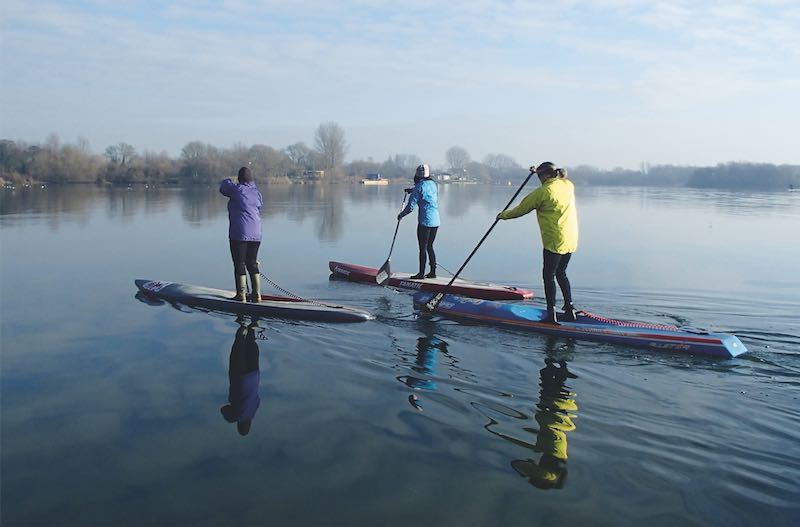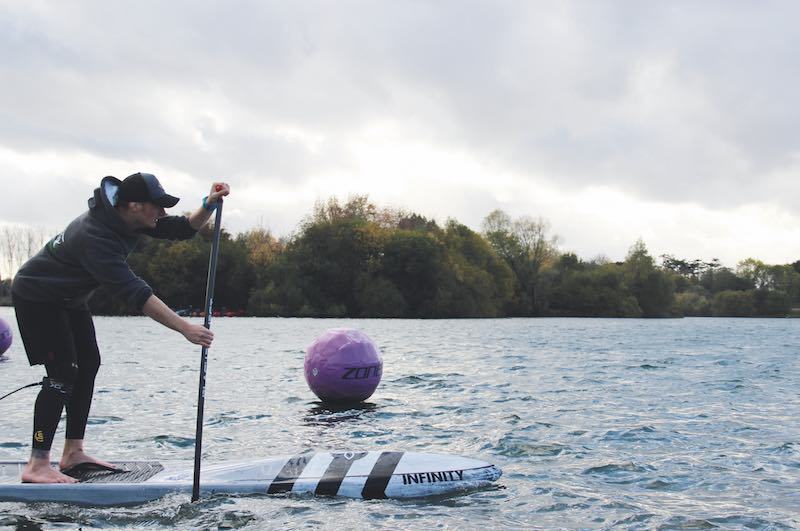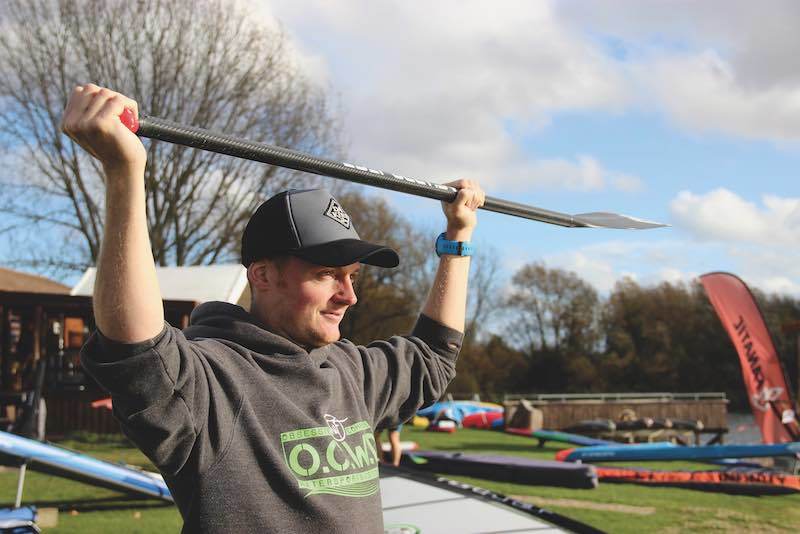
SUP: your alternative to winter swimming?
Eugenie Verney says stand-up paddleboarding is a great way to connect with the water in winter while avoiding the shakes and shivers
It’s mid-winter, spring seems a long way off, and the water temperature at your favourite outdoor spot is well into single figures.
Not a problem if you’ve embraced the joys of cold water. However, year-round swimming isn’t for everyone and there’s a lot to be said for a few months spent focusing on technique in a toasty indoor pool.
But wait. Suppose there was a way to get the best of both worlds? A way to stay in touch with your favourite stretch of water and maintain fitness without actually getting in? A way to enjoy the natural environment on bright frosty mornings without having to go through the after-drop?
Well, there is.
Try SUP in winter
Most of us no doubt associate stand-up paddleboarding with summer and of course that’s when most people do first give it a go. But in fact, SUP is also a great winter activity — and one that resonates with open water swimmers of all ages.
The main reason is simply feeling connected with the water. Standing on a paddleboard obviously isn’t as immersive as swimming, but the stress-busting sense of being at one with your surroundings is remarkably similar. A second, very practical, reason is that as swimmers we’re not afraid of the water — and that’s a particular bonus in winter. We obviously want to avoid falling off a paddleboard at lower temperatures, but we’re not going to completely freak out if we do. That said, it still makes sense to have some tuition if you’re a complete SUP newbie and always wear the right kit (see boxes).

A winter’s paddle at Bray Lake in Berkshire.
Image: Susan Jones
Low impact
A further bonus is that — like swimming — SUP can be done at any pace. You don’t need to be super-fit to get on the water and begin paddling, but if you do get hooked there are now multiple ways to build your fitness and compete. So how does that look in swimming terms? With SUP you can do pretty much everything from the equivalent of a gentle heads-up breaststroke potter to a flat-out fly sprint via a tough long-distance freestyle challenge at a strong and consistent speed.
As a low-impact workout, SUP complements swimming nicely. With the right technique, you’re working almost every muscle in your body, the core in particular. To maintain balance, you need to constantly engage your abdominal muscles and these — along with the muscles in your back and upper body — are put to work every time you paddle.
SUP helps build muscle strength in your arms, as well as strengthening your upper back and shoulders. Your leg muscles are also constantly engaging to help you keep balance and transfer weight, so they get stronger too.
Is there a direct pay-off for swimmers? There’s a shortage of research data, but anecdotally the answer is ‘yes’. Regular SUP training does seem to help swimming fitness by boosting your stroke power, reducing fatigue, and building stamina.
All in all, swimming and SUP are brilliant open water partners — oh, and cake is definitely on the post-SUP menu too!S

Your hands should be stacked over your paddle when you’re in the water, and not held at an angle across your body
CHOOSING THE RIGHT KIT
Stand-up paddleboards come in all shapes and sizes. It can make sense to rent until you’ve worked out what you’re primarily going to use yours for as what works on flat water may not work so well in surf.
The same applies to paddles: you’re far better off hiring at first and trying out several designs to find the best fit.
Safety first
When it comes to safety, there is one essential: you must fit your board with a leash and you must wear it in almost all conditions! If you do fall off your board becomes your main buoyancy aid, but only if you’re still attached to it. A personal flotation device (PFD) is strongly recommended, but is not a substitute for a leash — except in a few situations. Key among these is when more experienced paddlers navigate white water or a very fast-flowing river where there’s a risk the leash could become entangled.
Outerwear
A wetsuit can definitely boost your confidence while you’re still finding your feet. If you don’t already have one for swimming, go for a surf model as the fit is better for watersports — and see if you can hire before you buy.
A pair of neoprene energy pants is a good next step, as they will keep you warm both on the board and if you should get wet, as will a pair of neoprene boots. You can use swimming socks, but they’re generally not as robust as watersports boots and they won’t grip the board as well.
If you have the budget and intend SUPing a lot when it’s really cold a drysuit could be a worthwhile investment. But how well it will work depends on how well you layer underneath.
Getting this right is important — and not just with a drysuit. Even on very cold days, you’ll quickly warm up paddling so you need a combination that keeps you comfortable, without feeling cold at the start or hot later on.
Layer up
Begin with a good base layer — including putting tights under energy pants when it’s really cold. Then add at least one further layer and finally a jacket. The jacket doesn’t need to be fully waterproof unless you’re out in torrential rain. However, it does need to be properly windproof as that’s what will cool you down quickest.
A hat or warm buff for your head and gloves for your hands complete the winter kit. If you already have neoprene swim gloves, these work really well.
And just because it’s cold doesn’t mean you can skip hydration. If you’re using a PFD, choose one with a water reservoir. If not, invest in a good watersports-specific hydration pack or just secure a water bottle to your board with a cargo net.

How to grip your paddle
GETTING STARTED AND WHERE TO GO
Putting the foundations in place is important if you’re going to enjoy your stand-up paddleboarding and do it safely.
Among leading organisations delivering introductory SUP courses in the UK are the British Stand Up Paddleboarding Association (BSUPA), the Academy of Surf Instructors (ASI), and British Canoeing.
Simon Frost, owner at Bray Lake Watersports and a senior BSUPA instructor, runs a range of courses year-round.
“You can of course just buy a paddleboard and set off. But an introduction like the two-hour BSUPA Ready to Ride course will make a huge difference, not just to your safety but your confidence.”
For winter SUPing, it’s advisable to stick to lakes and rivers for your first year at least. At this time of year, rivers are at their quietest with far less boat traffic, but be sure to check the flow rate on the Environment Agency and SEPA websites before you set out.
You need a river licence to use most major inland waterways. You can get one covering England and Wales by becoming a British Canoeing member. Access in Scotland is less restricted, but always check before launching.
It’s best to get some proper coaching before heading for the coast. And never paddle alone in the sea.
Wherever you go, always remember to check the weather and water conditions and be prepared to turn back if necessary. It’s best to err on the side of caution.
FIND OUT MORE
There are some great ‘how to’SUP tuition videos on the Red Paddle Co’s website —
redpaddleco.com/en-gb/paddle-boarding-know/sup-tuition-videos/
More about BSUPA at bsupa.org.uk
More about Bray Lake at braylake.com/sup-tuition.html
More about British Canoeing at britishcanoeing.org.uk/membership








